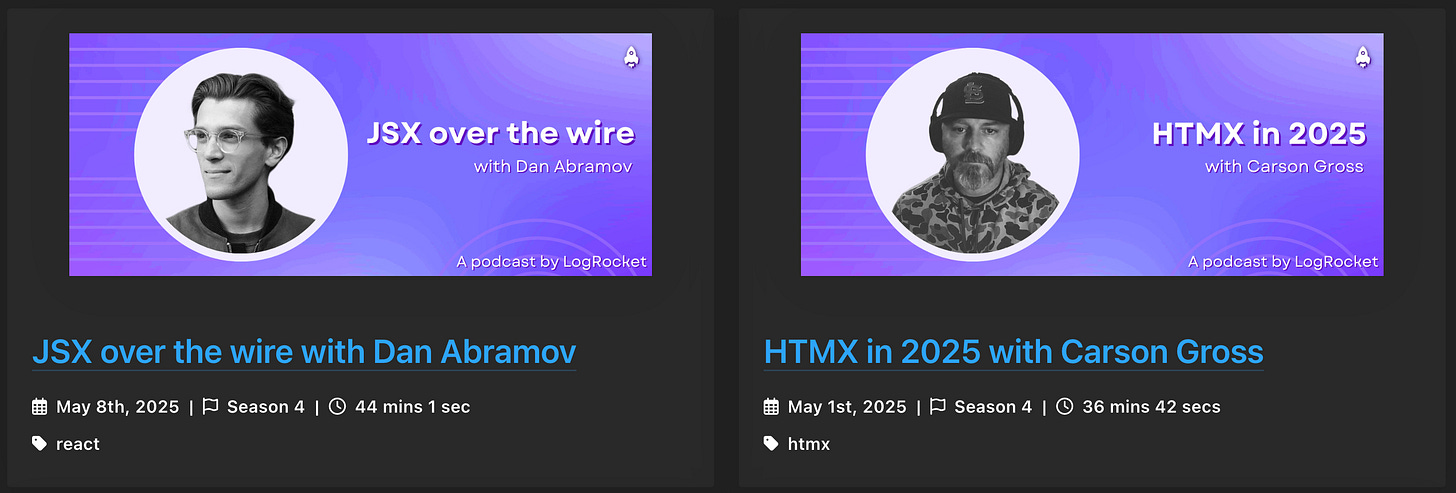May 2025: React, GraphQL, HTMX & Fixing a Plotly Quirk
Conversations with web legends, Apollo’s AI bets, and making your Plotly map finally remember where you left it.
Hello everyone,
I hope you had a good Memorial Day (US). The month of May has been mild in terms of temps, but busy around here as summer unofficially kicks off in many parts of the northern hemisphere.
This month I’ve got for you:
3 podcast episodes with smart folks in the web development space: Dan Abramov, Chris Gross, and Matt DeBergalis
A new blog post about persisting Plotly.js map state inside of a React application.
I think you’re going to like it.
May was a good month to be a host for the LogRocket podcast. I got to talk to Carson Gross, the creator of HTMX, and Dan Abramov, a well-known React core team member.
You may know about HTMX, due to its excellent meme game on social media sites like Twitter, but did you know that creator Carson Gross has built HTMX in such a way that he’s confident it could still work 100 years from now? It’s a fascinating conversation on how focusing on simplicity and stability may just be the key to building websites that don’t immediately become obsolete.
After a brief hiatus, React core team member Dan Abramov joined me once more to dive into a recent article on his blog about “JSX over the wire” and how it relates to React Server Components. In this episode, Dan shares how traditional REST APIs evolved over time, the concept of Backend for Frontend (BFF) arose, and why centering the UI around the user experience matters more than ever in a way that’s easy for anyone to grasp.
Dan’s also been dropping some serious knowledge over on his blog lately, and I would highly recommend you check it out if you want to better understand the thinking behind RSCs.
CTO and co-founder of Apollo, Matt DeBergalis, joined us on the Front-end Fire podcast to talk about how GraphQL has continued to evolve over time, and Apollo is betting big on AI.
GraphQL is less talked about than it was a few years ago, but companies like Apollo are still pushing the envelope on its capabilities and how well it could work with AI agents in the future.
Matt DeBergalis, CTO and co-founder of Apollo, shares how Apollo’s system can support APIs, serverless functions, SQL- or no SQL databases, and more, and how GraphQL schemas could work really well for showing AI agents and MCP servers how to access data.
I wrote another blog post focused on the Plotly.js data viz library. This one’s about maintaining Plotly.js map state inside of a React web app across component re-renders.
When I was building a Next.js-based data visualization-heavy dashboard at work, I ended up using the Plotly.js and React-Plotly libraries for the many different data viz options available to me and the highly customizable nature of these visualizations.
A “quirk” I encountered while crafting a Plotly map to sit alongside the charts, however, was that after I zoomed or scrolled around the map just a bit, when the app would re-render (as React apps are wont to do) it would reset to its original map coordinates and zoom level like the page had just been loaded. Annoying, and not well described in the docs how to fix.
In this latest article, I share how to build your own map component using Plotly, and persist the user’s last map settings across re-renders via some a little state handling in the parent component.
Here’s a demo video to illustrate how a map should behave in a React app regardless of what else is re-rendering around it.
I hope you enjoyed this month’s edition of “Paige Codes.” Please share with your friends if you did.
See you again at the end of June,
- Paige
Not subscribed yet? No worries.
I send a free email every month or so. You can check out my archive, or sign up below:



